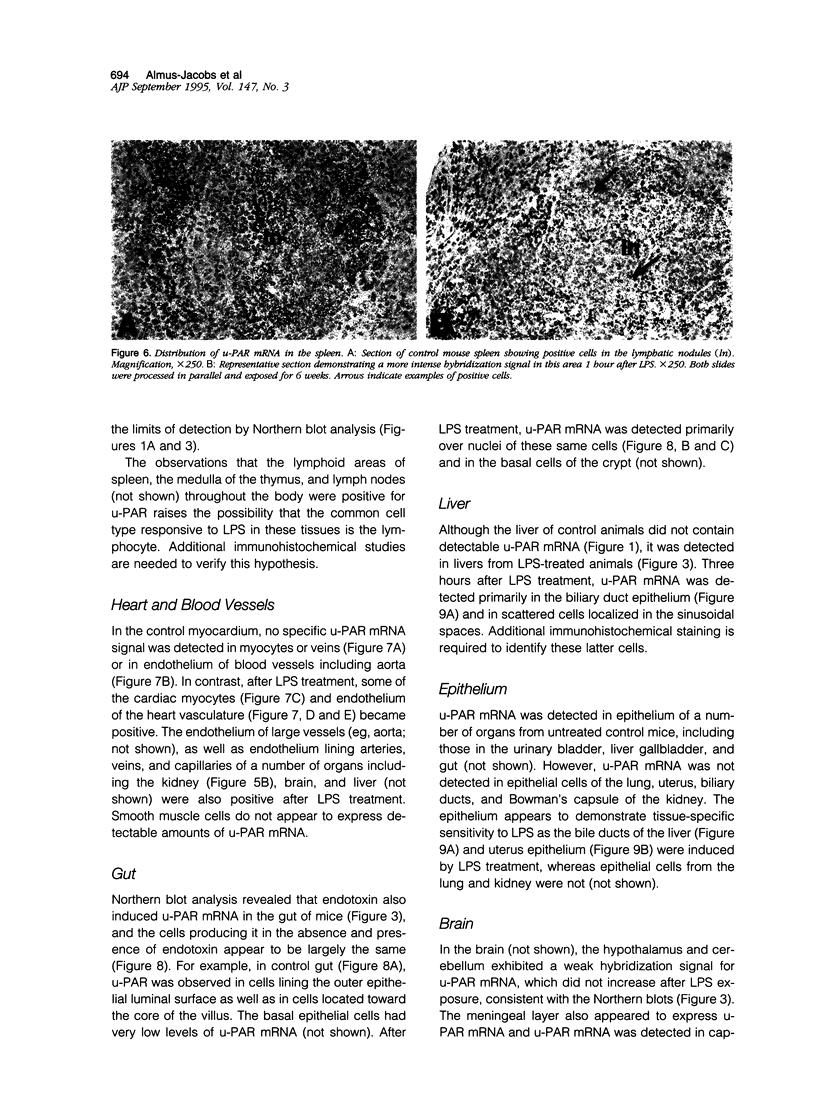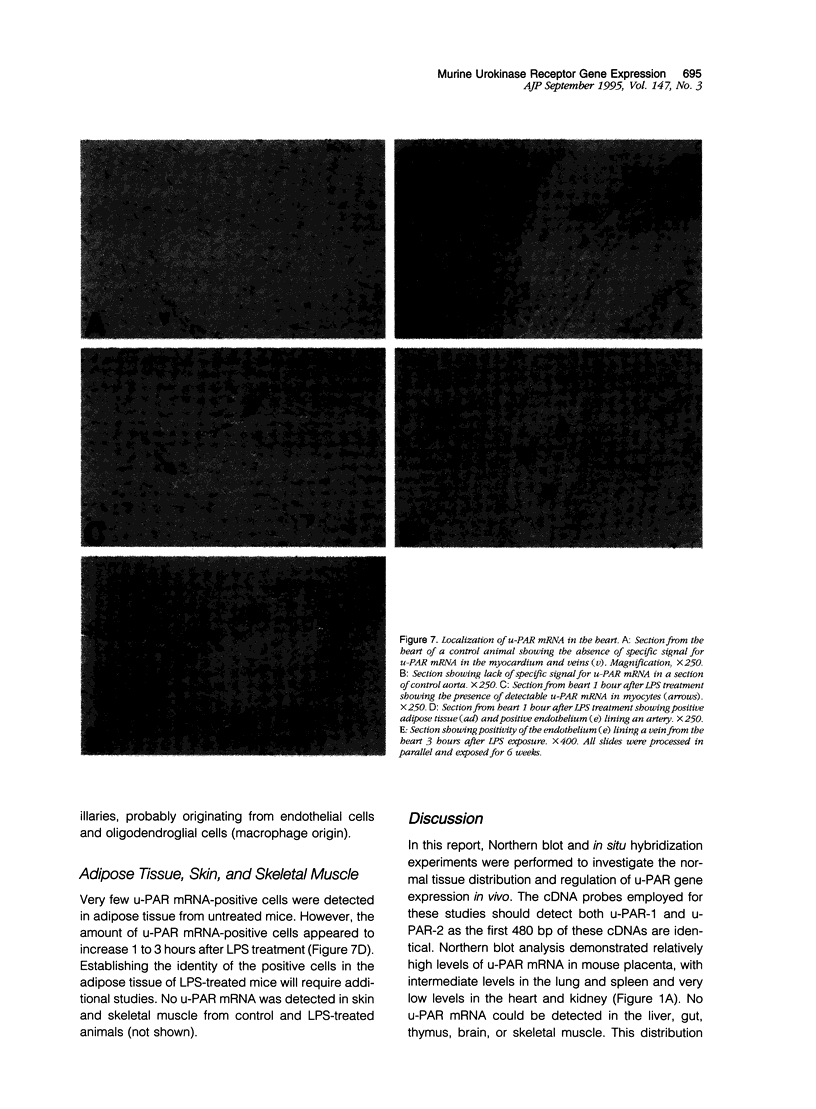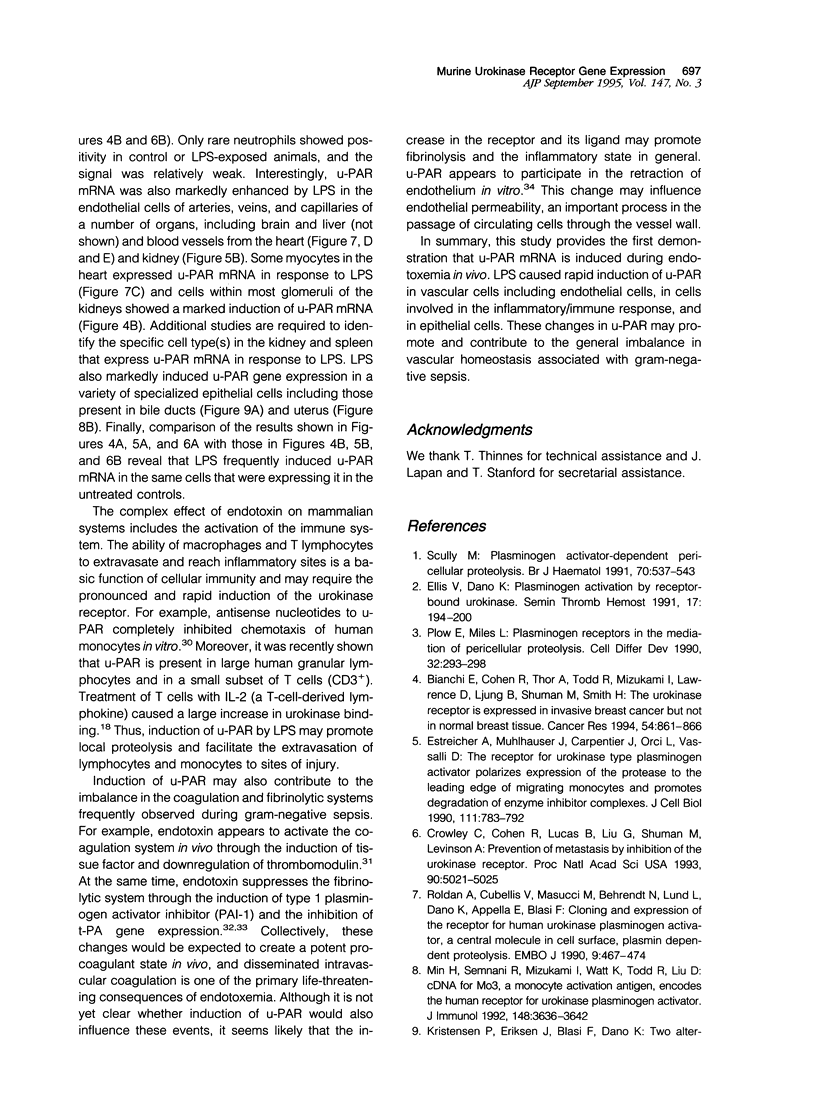Abstract
The regulation of urokinase receptor (u-PAR) gene expression during endotoxemia was studied in vivo with a murine model system. Northern blot analysis demonstrated relatively high levels of u-PAR mRNA in mouse placenta, with intermediate levels in lung and spleen and very low levels in heart and kidney. No u-PAR mRNA could be detected in liver, gut, thymus, brain, or skeletal muscle. Intraperitoneal injection of endotoxin (lipopolysaccharide) increased the steady-state levels of u-PAR mRNA in most tissues examined. The greatest induction (sevenfold) was observed in the lung at 1 hour after injection. The cellular localization of u-PAR mRNA was assessed by in situ hybridization. In control mice, u-PAR mRNA was detected primarily in alveolar macrophages of the lung and lymphocytes of the spleen and thymus, although a specific signal was also present in other cell types. In general, endothelial cells lacked detectable u-PAR mRNA. The induction of u-PAR mRNA by lipopolysaccharide was apparent within 30 minutes and was localized to tissue macrophages, lymphocytes, and endothelial cells lining arteries and veins. At later times (1 to 3 hours), specialized epithelial cells present in gastrointestinal tract, bile ducts, and uterus were also positive for u-PAR mRNA. Induction of u-PAR in vivo by lipopolysaccharide may facilitate the extravasation and migration of leukocytes during inflammation.
Full text
PDF










Images in this article
Selected References
These references are in PubMed. This may not be the complete list of references from this article.
- Behrendt N., Rønne E., Ploug M., Petri T., Løber D., Nielsen L. S., Schleuning W. D., Blasi F., Appella E., Danø K. The human receptor for urokinase plasminogen activator. NH2-terminal amino acid sequence and glycosylation variants. J Biol Chem. 1990 Apr 15;265(11):6453–6460. [PubMed] [Google Scholar]
- Bianchi E., Cohen R. L., Thor A. T., Todd R. F., 3rd, Mizukami I. F., Lawrence D. A., Ljung B. M., Shuman M. A., Smith H. S. The urokinase receptor is expressed in invasive breast cancer but not in normal breast tissue. Cancer Res. 1994 Feb 15;54(4):861–866. [PubMed] [Google Scholar]
- Cassady A. I., Stacey K. J., Nimmo K. A., Murphy K. M., von der Ahe D., Pearson D., Botteri F. M., Nagamine Y., Hume D. A. Constitutive expression of the urokinase plasminogen activator gene in murine RAW264 macrophages involves distal and 5' non-coding sequences that are conserved between mouse and pig. Nucleic Acids Res. 1991 Dec 25;19(24):6839–6847. doi: 10.1093/nar/19.24.6839. [DOI] [PMC free article] [PubMed] [Google Scholar]
- Chomczynski P., Sacchi N. Single-step method of RNA isolation by acid guanidinium thiocyanate-phenol-chloroform extraction. Anal Biochem. 1987 Apr;162(1):156–159. doi: 10.1006/abio.1987.9999. [DOI] [PubMed] [Google Scholar]
- Conforti G., Dominguez-Jimenez C., Rønne E., Høyer-Hansen G., Dejana E. Cell-surface plasminogen activation causes a retraction of in vitro cultured human umbilical vein endothelial cell monolayer. Blood. 1994 Feb 15;83(4):994–1005. [PubMed] [Google Scholar]
- Crowley C. W., Cohen R. L., Lucas B. K., Liu G., Shuman M. A., Levinson A. D. Prevention of metastasis by inhibition of the urokinase receptor. Proc Natl Acad Sci U S A. 1993 Jun 1;90(11):5021–5025. doi: 10.1073/pnas.90.11.5021. [DOI] [PMC free article] [PubMed] [Google Scholar]
- Ellis V., Danø K. Plasminogen activation by receptor-bound urokinase. Semin Thromb Hemost. 1991 Jul;17(3):194–200. doi: 10.1055/s-2007-1002609. [DOI] [PubMed] [Google Scholar]
- Estreicher A., Mühlhauser J., Carpentier J. L., Orci L., Vassalli J. D. The receptor for urokinase type plasminogen activator polarizes expression of the protease to the leading edge of migrating monocytes and promotes degradation of enzyme inhibitor complexes. J Cell Biol. 1990 Aug;111(2):783–792. doi: 10.1083/jcb.111.2.783. [DOI] [PMC free article] [PubMed] [Google Scholar]
- Gyetko M. R., Todd R. F., 3rd, Wilkinson C. C., Sitrin R. G. The urokinase receptor is required for human monocyte chemotaxis in vitro. J Clin Invest. 1994 Apr;93(4):1380–1387. doi: 10.1172/JCI117114. [DOI] [PMC free article] [PubMed] [Google Scholar]
- Kirchheimer J. C., Nong Y. H., Remold H. G. IFN-gamma, tumor necrosis factor-alpha, and urokinase regulate the expression of urokinase receptors on human monocytes. J Immunol. 1988 Dec 15;141(12):4229–4234. [PubMed] [Google Scholar]
- Kristensen P., Eriksen J., Danø K. Localization of urokinase-type plasminogen activator messenger RNA in the normal mouse by in situ hybridization. J Histochem Cytochem. 1991 Mar;39(3):341–349. doi: 10.1177/39.3.1899685. [DOI] [PubMed] [Google Scholar]
- Krätzschmar J., Haendler B., Kojima S., Rifkin D. B., Schleuning W. D. Bovine urokinase-type plasminogen activator and its receptor: cloning and induction by retinoic acid. Gene. 1993 Mar 30;125(2):177–183. doi: 10.1016/0378-1119(93)90325-w. [DOI] [PubMed] [Google Scholar]
- Larsson L. I., Skriver L., Nielsen L. S., Grøndahl-Hansen J., Kristensen P., Danø K. Distribution of urokinase-type plasminogen activator immunoreactivity in the mouse. J Cell Biol. 1984 Mar;98(3):894–903. doi: 10.1083/jcb.98.3.894. [DOI] [PMC free article] [PubMed] [Google Scholar]
- Mignatti P., Mazzieri R., Rifkin D. B. Expression of the urokinase receptor in vascular endothelial cells is stimulated by basic fibroblast growth factor. J Cell Biol. 1991 Jun;113(5):1193–1201. doi: 10.1083/jcb.113.5.1193. [DOI] [PMC free article] [PubMed] [Google Scholar]
- Min H. Y., Semnani R., Mizukami I. F., Watt K., Todd R. F., 3rd, Liu D. Y. cDNA for Mo3, a monocyte activation antigen, encodes the human receptor for urokinase plasminogen activator. J Immunol. 1992 Jun 1;148(11):3636–3642. [PubMed] [Google Scholar]
- Mroczka D. L., Cassidy B., Busch H., Rothblum L. I. Characterization of rat ribosomal DNA. The highly repetitive sequences that flank the ribosomal RNA transcription unit are homologous and contain RNA polymerase III transcription initiation sites. J Mol Biol. 1984 Mar 25;174(1):141–162. doi: 10.1016/0022-2836(84)90369-3. [DOI] [PubMed] [Google Scholar]
- Nawroth P. P., Handley D. A., Esmon C. T., Stern D. M. Interleukin 1 induces endothelial cell procoagulant while suppressing cell-surface anticoagulant activity. Proc Natl Acad Sci U S A. 1986 May;83(10):3460–3464. doi: 10.1073/pnas.83.10.3460. [DOI] [PMC free article] [PubMed] [Google Scholar]
- Nykjaer A., Møller B., Todd R. F., 3rd, Christensen T., Andreasen P. A., Gliemann J., Petersen C. M. Urokinase receptor. An activation antigen in human T lymphocytes. J Immunol. 1994 Jan 15;152(2):505–516. [PubMed] [Google Scholar]
- Nykjaer A., Petersen C. M., Møller B., Andreasen P. A., Gliemann J. Identification and characterization of urokinase receptors in natural killer cells and T-cell-derived lymphokine activated killer cells. FEBS Lett. 1992 Mar 23;300(1):13–17. doi: 10.1016/0014-5793(92)80154-9. [DOI] [PubMed] [Google Scholar]
- Palfree R. G. The urokinase-type plasminogen activator receptor is a member of the Ly-6 superfamily. Immunol Today. 1991 May;12(5):170–170. doi: 10.1016/S0167-5699(05)80051-9. [DOI] [PubMed] [Google Scholar]
- Ploug M., Behrendt N., Løber D., Danø K. Protein structure and membrane anchorage of the cellular receptor for urokinase-type plasminogen activator. Semin Thromb Hemost. 1991 Jul;17(3):183–193. doi: 10.1055/s-2007-1002608. [DOI] [PubMed] [Google Scholar]
- Ploug M., Plesner T., Rønne E., Ellis V., Høyer-Hansen G., Hansen N. E., Danø K. The receptor for urokinase-type plasminogen activator is deficient on peripheral blood leukocytes in patients with paroxysmal nocturnal hemoglobinuria. Blood. 1992 Mar 15;79(6):1447–1455. [PubMed] [Google Scholar]
- Plow E. F., Miles L. A. Plasminogen receptors in the mediation of pericellular proteolysis. Cell Differ Dev. 1990 Dec 2;32(3):293–298. doi: 10.1016/0922-3371(90)90042-u. [DOI] [PubMed] [Google Scholar]
- Pyke C., Eriksen J., Solberg H., Nielsen B. S., Kristensen P., Lund L. R., Danø K. An alternatively spliced variant of mRNA for the human receptor for urokinase plasminogen activator. FEBS Lett. 1993 Jul 12;326(1-3):69–74. doi: 10.1016/0014-5793(93)81763-p. [DOI] [PubMed] [Google Scholar]
- Raetz C. R. Biochemistry of endotoxins. Annu Rev Biochem. 1990;59:129–170. doi: 10.1146/annurev.bi.59.070190.001021. [DOI] [PubMed] [Google Scholar]
- Roldan A. L., Cubellis M. V., Masucci M. T., Behrendt N., Lund L. R., Danø K., Appella E., Blasi F. Cloning and expression of the receptor for human urokinase plasminogen activator, a central molecule in cell surface, plasmin dependent proteolysis. EMBO J. 1990 Feb;9(2):467–474. doi: 10.1002/j.1460-2075.1990.tb08132.x. [DOI] [PMC free article] [PubMed] [Google Scholar]
- Sappino A. P., Huarte J., Vassalli J. D., Belin D. Sites of synthesis of urokinase and tissue-type plasminogen activators in the murine kidney. J Clin Invest. 1991 Mar;87(3):962–970. doi: 10.1172/JCI115104. [DOI] [PMC free article] [PubMed] [Google Scholar]
- Schleef R. R., Bevilacqua M. P., Sawdey M., Gimbrone M. A., Jr, Loskutoff D. J. Cytokine activation of vascular endothelium. Effects on tissue-type plasminogen activator and type 1 plasminogen activator inhibitor. J Biol Chem. 1988 Apr 25;263(12):5797–5803. [PubMed] [Google Scholar]
- Schneiderman J., Sawdey M. S., Keeton M. R., Bordin G. M., Bernstein E. F., Dilley R. B., Loskutoff D. J. Increased type 1 plasminogen activator inhibitor gene expression in atherosclerotic human arteries. Proc Natl Acad Sci U S A. 1992 Aug 1;89(15):6998–7002. doi: 10.1073/pnas.89.15.6998. [DOI] [PMC free article] [PubMed] [Google Scholar]
- Scully M. F. Plasminogen activator-dependent pericellular proteolysis. Br J Haematol. 1991 Dec;79(4):537–543. doi: 10.1111/j.1365-2141.1991.tb08078.x. [DOI] [PubMed] [Google Scholar]
- Suffredini A. F., Harpel P. C., Parrillo J. E. Promotion and subsequent inhibition of plasminogen activation after administration of intravenous endotoxin to normal subjects. N Engl J Med. 1989 May 4;320(18):1165–1172. doi: 10.1056/NEJM198905043201802. [DOI] [PubMed] [Google Scholar]
- Wilcox J. N., Gee C. E., Roberts J. L. In situ cDNA:mRNA hybridization: development of a technique to measure mRNA levels in individual cells. Methods Enzymol. 1986;124:510–533. doi: 10.1016/0076-6879(86)24037-9. [DOI] [PubMed] [Google Scholar]











